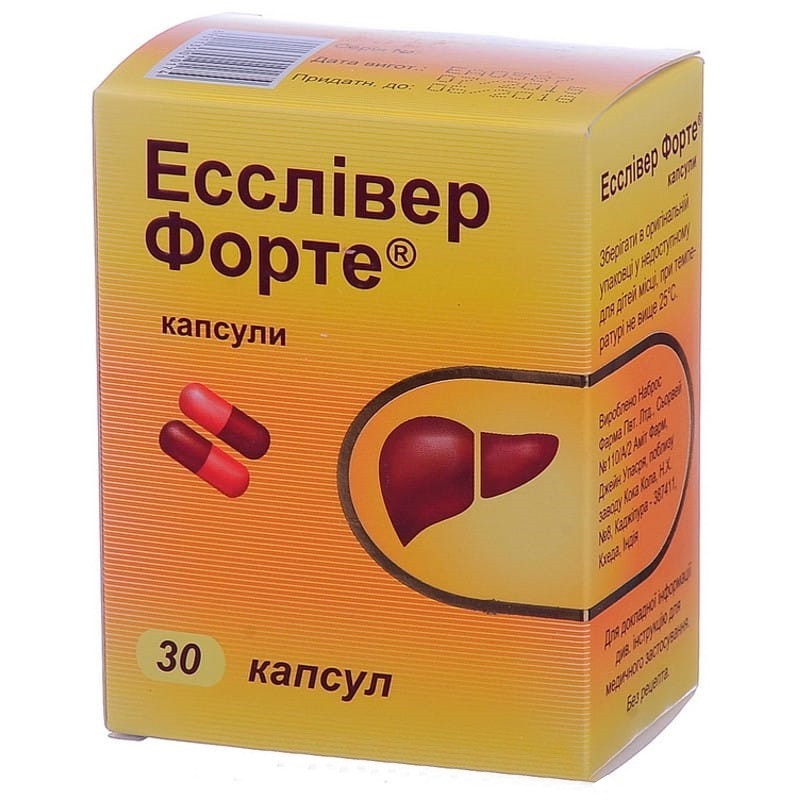



 Secure and encrypted payment processing
Secure and encrypted payment processing We ship to over 40 countries including the USA, UK, Europe, Australia and Japan
We ship to over 40 countries including the USA, UK, Europe, Australia and Japan Guaranteed refund or reship if you haven't received your order
Guaranteed refund or reship if you haven't received your orderThe main active ingredient of the drug is natural phospholipids (substance epl). phospholipids in their chemical structure are similar to endogenous phospholipids, but surpass them due to the high content of polyunsaturated fatty acids. these molecules are embedded mainly in the structure of cell membranes and facilitate the restoration of damaged liver tissues. phospholipids have a hepatoprotective effect in case of damage to liver cells by viruses, alcohol, and toxic substances. in cells, the rate of entry and removal of substances increases, the restoration of enzyme systems and the improvement of liver metabolism are ensured.
Phospholipids affect impaired fat metabolism by regulating lipoprotein metabolism, as a result of which neutral fats and cholesterol turn into forms suitable for transportation, especially due to the increased ability of HDL to attach cholesterol, and are sent for further oxidation. When phospholipids are excreted through the biliary tract, the lithogenic index decreases and bile stabilizes.
The vitamin complex performs the following functions: nicotinamide has a lipid-lowering effect and prevents fatty degeneration of the liver; pyridoxine as a coenzyme takes part in the metabolism of phospholipids, amino acids and proteins; thiamine is involved in carbohydrate metabolism; riboflavin is a cofactor of numerous respiratory enzymes; tocopherol acts as an antioxidant at the level of the cell membrane, prevents the oxidation of unsaturated fatty acids.
When taken orally, more than 90% of the drug is absorbed in the small intestine. The main amount is cleaved by phospholipase-A to 1-acyl-lyso-phosphatidylcholine, 50% of which is immediately cleaved into polyunsaturated phosphatidylcholine even during absorption in the small intestine. Polyunsaturated phosphatidylcholine enters the bloodstream through the lymphatic tract and then, mainly in combination with HDL, is transported to the liver. The maximum content of phosphatidylcholine in the blood 6-24 hours after oral administration is an average of 20%.
Fatty liver degeneration (including liver damage in diabetes), acute and chronic hepatitis, liver cirrhosis, pre- and postoperative treatment of a patient with surgery on the liver and biliary tract, toxic liver damage, pregnancy toxicosis, psoriasis, radiation syndrome.
The dose for adults and children over the age of 12 years is usually 1-2 capsules 3 times a day. take capsules with meals, without chewing, with a little water.
Doses of the drug and the duration of treatment are determined by the doctor individually for each patient, taking into account the nature and severity of the pathological process, the characteristics of the course of the disease, the achieved therapeutic effect and tolerability of the drug. On average, the course of treatment is at least 3 months.
Treatment of psoriasis begins with the appointment of the drug 2 capsules 3 times a day for 2 weeks, and then, in combination with conventional methods of treating psoriasis, 1 capsule 3 times a day for 2 months.
Hypersensitivity to the components of the drug. allergic diseases. intrahepatic cholestasis. an ulcer of the stomach and duodenum in the acute stage.
In some cases, the use of the drug may cause the following side effects.
From the digestive tract: dyspeptic disorders, nausea, vomiting, diarrhea, constipation, heartburn, discomfort and pain in the epigastrium.
On the part of the skin and subcutaneous tissue: skin rash, urticaria, itching.
In individuals with individual intolerance to any component of the drug, hypersensitivity reactions are possible, including angioedema, anaphylaxis.
It is possible to stain urine in yellow.
With caution and after consulting a doctor, use the drug for severe diseases of the heart, kidneys, increased risk of developing thromboembolism, patients with a history of gastric and duodenal ulcers, for neoplasms, nephrolithiasis, erythremia, erythrocytosis, hyperuricemia.
The use of the drug can lead to a false positive test for urobilinogen using Ehrlich reagent.
Use during pregnancy and lactation. The drug can be used during pregnancy and lactation according to the indications as prescribed and under the supervision of a doctor.
Children. It is used to treat children from 12 years old.
The ability to influence the reaction rate when driving vehicles or working with other mechanisms. Does not affect.
Vitamin B6 weakens the effect of levodopa, prevents or reduces the toxic effects that develop with the use of isoniazid and other anti-TB drugs.
PASK, cimetidine, calcium preparations, ethanol reduce the absorption of vitamin B12.
Riboflavin is incompatible with streptomycin and reduces the effectiveness of antibacterial drugs (oxytetracycline, doxycycline, erythromycin, tetracycline and lincomycin). Tricyclic antidepressants, imipramine and amitriptyline, inhibit the metabolism of riboflavin, especially in the heart tissue.
It is not recommended to prescribe simultaneously with other multivitamin preparations, since an overdose of the latter in the body is possible.
Vitamin E can not be used simultaneously with iron, silver preparations, agents with an alkaline environment (sodium bicarbonate, trisamine), indirect anticoagulants (dicumarin, neodicumarin).
Vitamin E enhances the effects of steroidal and non-steroidal anti-inflammatory drugs (sodium diclofenac, ibuprofen, prednisone), reduces the toxic effects of cardiac glycosides (digitoxin, digoxin), vitamins A and D. The administration of vitamin E in high doses can cause vitamin A deficiency in the body.
Vitamin E and its metabolites exhibit an antagonistic effect with respect to vitamin K. Increases the effectiveness of antiepileptic drugs in patients with epilepsy (in which the content of lipid peroxidation products in the blood is increased).
Colestyramine, colestipol, mineral oils reduce the absorption of vitamin E.
Symptoms: nausea, vomiting, diarrhea, headache, drowsiness, lethargy, facial flushing, irritability, increased manifestations of adverse reactions. with prolonged use in high doses, peripheral neuropathy is possible.
Treatment: gastric lavage, the appointment of activated charcoal, hyperosmotic laxatives.
At a temperature not exceeding 25 ° C.